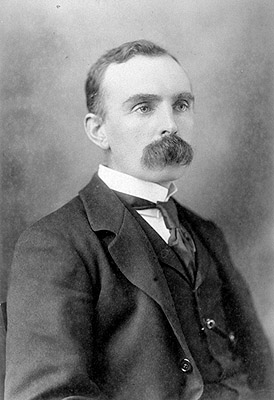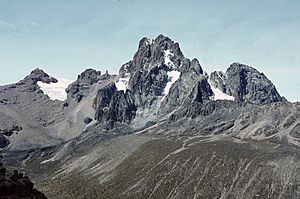John Walter Gregory facts for kids
Quick facts for kids
John Walter Gregory, FRS
|
|
|---|---|
 |
|
| Born | 27 January 1864 Bow, London
|
| Died | 2 June 1932 (aged 68) Megantoni Rapids, Urubamba River, Peru
|
| Occupation | Geologist and explorer |
| Awards | Bigsby Medal (1905) |
John Walter Gregory (born January 27, 1864 – died June 2, 1932) was a British geologist and explorer. He is best known for his work on glacial geology (the study of glaciers and their effects) and for exploring the geography and geology of Australia and East Africa.
The Gregory Rift, a large valley in East Africa, is named after him.
Contents
Early Life and Education
John Walter Gregory was born in Bow, London, England. He was the only son of John James Gregory, a wool merchant.
When he was 15, Gregory started working as a clerk in wool sales. He also took evening classes at the Birkbeck Literary and Scientific Institution, which is now Birkbeck, University of London. He worked hard and earned his Bachelor of Science (BSc) degree in 1891 and his Doctor of Science (D. Sc.) degree in 1893.
In 1887, he became an assistant in the geology department at the Natural History Museum, London.
A Career of Discovery
Gregory worked at the Natural History Museum until 1900. During this time, he wrote important books about fossils. He also traveled a lot, visiting places like Europe, the West Indies, North America, and East Africa.
His book, The Great Rift Valley (1896), tells the story of his journey to Mount Kenya and Lake Baringo in 1892–93. Gregory was the first person to lead a scientific trip specifically to Mount Kenya. He made important discoveries about the mountain's geology that are still true today.
He also tried to climb Mount Kenya, going past the forests and moorlands to the glaciers and snow. The Gregory Glacier, which is now much smaller, was named after him. He also named other glaciers on the mountain after famous scientists. In 1896, he joined an expedition to Spitsbergen, an island in the Arctic, where he did excellent work studying glaciers.
Gregory was briefly chosen to lead the scientific team for the Discovery Expedition to Antarctica in 1900. However, he had to leave the role because he would have been outranked by the expedition's commander, Robert Falcon Scott.
Adventures in Australia
In 1899, Gregory was appointed a professor of geology at the University of Melbourne in Australia. He started his new job in February 1900. Even though he stayed in Australia for less than five years, his work had a lasting impact. He taught many students and was very popular.
While in Australia, he faced challenges because the university had financial problems. In 1904, he accepted a new job as a geology professor at the University of Glasgow in Scotland.
During his time in Australia, Gregory explored a lot. In 1901–02, he traveled around Lake Eyre in Central Australia. He wrote a book about this journey called The Dead Heart of Australia (1906). He also wrote books for schools, like The Austral Geography (1902) and The Geography of Victoria (1903).
He was also the director of the Geological Survey of Victoria starting in 1901. In the same year, he became a member of the Royal Society in London, a very important scientific group.
Teaching in Glasgow
In 1904, Gregory became the professor of Geology at Glasgow University. He held this position for 25 years and became known as a great teacher and leader. In 1905, he was elected a Fellow of the Royal Society of Edinburgh.
After he retired in 1929, Gregory continued to go on expeditions. He traveled to Cyrenaica in North Africa in 1908 and to southern Angola in 1912. He also went to Tibet with his son, and they wrote a book about it called To the Alps of Chinese Tibet (1923).
He wrote many other books about geology and geography, including:
- Geography: Structural Physical and Compartitive (1908)
- Geology (1910)
- The Nature and Origin of Fiords (1913)
- Geology of To-Day (1915)
- The Rift Valleys and Geology of East Africa (1921)
- The Elements of Economic Geology (1927)
- General Stratigraphy (with B. H. Barrett) (1931)
- Dalradian Geology (1931)
He also wrote books on other topics, such as The Story of the Road (1931).
Final Expedition and Death
In January 1932, Gregory went on an expedition to South America. He wanted to study the volcanoes and earthquake areas of the Andes mountains in Peru. This trip was supported by the Royal Geographical Society in London.
Sadly, on June 2, 1932, his boat overturned in the Urubamba River in southern Peru, and he drowned. He was 68 years old. One of his companions, Victor Coverley-Price, was also in the canoe but survived and later wrote about the expedition.
Legacy and Honours
John Walter Gregory was the president of the Geological Society of London from 1928 to 1930. He received many scientific awards, including the Bigsby Medal in 1905. Besides his books, he wrote about 300 papers on geology, geography, and other subjects.
Gregory was a humble and sincere person with many interests. He worked very quickly and achieved a lot. He was one of the most important geologists of his time and was well-known around the world. Many of his books were interesting for both scientists and the general public. He greatly influenced the knowledge of his era as a scientist, teacher, traveler, and writer.
The Gregory Rift in the Great Rift Valley is named in his honour. He visited central Kenya in 1893 and again in 1919. His 1896 book The Great Rift Valley is considered a classic. He was the first to use the term "rift valley," describing it as "a long valley with parallel and almost straight sides, which has sunk down because of a series of parallel cracks in the Earth."
The mineral gregoryite, first found in the Great Rift Valley, is also named after him.
Family
John Walter Gregory married Audrey Chaplin. They had a son and a daughter.
Selected Works
- The living races of mankind: a popular illustrated account of the customs, habits, pursuits, feasts and ceremonies of the races of mankind throughout the world By Henry Neville Hutchinson, John Walter Gregory, Richard Lydekker (1902)
- The Living Races of Mankind By Richard Lydekker, Henry Neville Hutchinson, John Walter Gregory (1985)
- Gregory, J.W. 1911. The terms "Denudation," "Erosion," "Corrosion," and "Corrasion". The Geographical Journal 37(2):189–195.
- Gregory, J.W. 1914. The lake system of Westralia. The Geographical Journal 43(6):656–664.
Biography
Leake, B. E. 2011. The Life and Work of Professor J. W. Gregory FRS (1864– 1932): Geologist, Writer and Explorer. Geological Society, London, Memoirs, 34., ISBN: 1-86239-323-0 and ISBN: 978-1-86239-323-3
Archives
John Walter Gregory's papers and records are kept at the Archives of the University of Glasgow.


